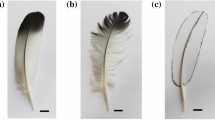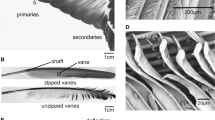Abstract
Many species of owls are able to fly noiselessly, and their wing feathers play an important role for the silent flight. In this paper, we studied the sound suppression mechanism of the eagle owl (Bubo bubo) by Stereo Microscope (SM), Scanning Electron Microscopy (SEM) and Laser Scanning Confocal Microscope (LSCM). To investigate the effects of special characteristics of wing feather on owl silent flight, the acoustic properties, including the sound absorption coefficient and flight noise, were compared between the eagle owl and common buzzard (Buteo buteo). The results show that the eagle owl generates lower noise than common buzzard during flight, and its wing feather has better sound absorption properties. The leading edge serration and trailing edge fringe can improve the pressure fluctuation of turbulence boundary, and suppress the generation of vortex sound. The elongated distal barbules form a multi-layer grid porous structure which also has an effect on sound absorption. This research not only can give the inspiration for solving the aerodynamic noise of aircraft and engineering machine, but also can provide a new idea for the design of low-noise devices.
Similar content being viewed by others
References
Lilley G M. A study of the silent flight of the owl. AIAA paper, 1998, AIAA-1998-2340.
Gruschka H D, Borchers I U, Coble J G. Aerodynamic noise produced by a gliding owl. Nature, 1971, 233, 409–441.
Kroeger R A, Grushka H D, Helvey T C. Low Speed AeroDynamics for Ultra-Quiet Flight, Technical Report AFFDL-TR-71-75, Air Force Flight Dynamics Lab, Wright-Patterson Air Force Base, Ohio, USA, 1971.
Neuhaus W, Bretting H, Schweizer B. Morphologische und funktionelle Untersuchungen über den “lautlosen” Flug der Eulen (Strix aluco) im Vergleich zum Flug der Enten (Anas platyrhynchos). Biologisches Zentralblatt, 1973, 92, 495–512. (in German)
Geyer T, Sarradj E, Fritzsche C. Silent owl flight: Experiments in the aeroacoustic wind tunnel. The NAG/DAGA 2009 International Conference on Acoustics, Rotterdam, The Netherlands, 2009.
Sarradj E, Fritzsche C, Geyer T. Silent owl flight, bird flyover noise measurements. AIAA Journal, 2011, 49, 769–779.
Graham R R. The silent flight of owls. The Journal of the Royal Aeronautical Society, 1934, 38, 837–843.
Sick H. Morphologisch-funktionelle Untersuchungen über die Feinstruktur der Vogelfeder. Journal für Ornithologie, 1937, 85, 206–372. (in German)
Bachmann T, Klän S, Baumgartner W, Klaas M, Schröder W, Wagner H. Morphometric characterisation of wing feathers of the barn owl Tyto alba pratincola and the pigeon Columba livia. Frontiers in Zoology, 2007, 4, 23.
Bachmann T, Wagner H. The three-dimensional shape of serrations at barn owl wings, towards a typical natural serration as a role model for biomimetic applications. Journal of Anatomy, 2011, 219, 192–202.
Ren L Q, Liang Y H. Biological couplings, Classification and characteristic rules. Science in China E: Technological Sciences, 2009, 52, 2791–2800.
Sun S M, Ren L Q, Xun C Y. Research on coupling sound absorption property of owl skin and feather. Noise and Vibration Control, 2008, 6, 119–123. (in Chinese)
Liu T S, Kuykendoll K, Rhew R, Jones S. Avian wings. AIAA Paper, 2004, AIAA-2004-2186.
Soderman P T. Leading-Edge Serrations which Reduce the Noise of Low-Speed Rotors, NASA Technical Report, NASA TN D-7371, USA, 1973.
Vad J, Koscsó G, Gutermuth M, Kasza Z, Tábi T, Csörgő T. Study of the aero-acoustic and aerodynamic effects of soft coating upon airfoil. JSME International Journal C, 2006, 49, 648–656.
Shinichiro I T O. Aerodynamic influence of leading edge serrations on an airfoil in a low Reynolds number. Journal of Biomechanical Science and Engineering, 2009, 4, 117–123.
Herr M, Dobrzynski W. Experimental investigations in low-noise trailing-edge design. AIAA Journal, 2005, 43, 1167–1175.
Geyer T, Sarradj E, Fritzsche C. Measurement of the noise generation at the trailing edge of porous airfoils. Experiments in Fluids, 2010, 48, 291–308.
Author information
Authors and Affiliations
Corresponding author
Rights and permissions
About this article
Cite this article
Chen, K., Liu, Q., Liao, G. et al. The Sound Suppression Characteristics of Wing Feather of Owl (Bubo bubo). J Bionic Eng 9, 192–199 (2012). https://doi.org/10.1016/S1672-6529(11)60109-1
Published:
Issue Date:
DOI: https://doi.org/10.1016/S1672-6529(11)60109-1




